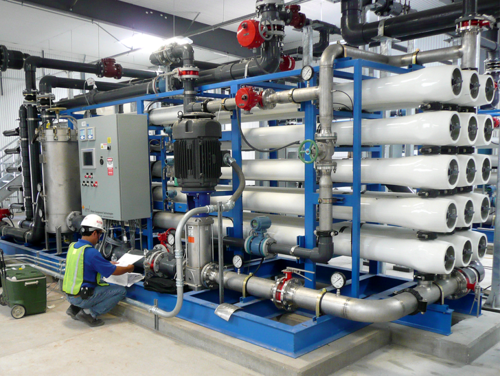Your Guide to PFAS Therapy Technologies and Conveniences
The frequency of PFAS contamination in water resources demands a comprehensive understanding of available therapy modern technologies. Various approaches, such as triggered carbon purification, ion exchange systems, and advanced oxidation procedures, existing distinct benefits in dealing with these relentless contaminants. Each technology not just targets particular PFAS substances yet likewise plays a vital function in boosting general water quality and protecting ecological honesty. As neighborhoods grapple with the implications of PFAS direct exposure, the option of a suitable therapy technique ends up being progressively essential, prompting a more detailed examination of these innovations and their particular advantages.
Recognizing PFAS Contamination
Understanding PFAS contamination is critical for addressing its prevalent influence on ecological and human health and wellness (m270 pfas treatment). Per- and polyfluoroalkyl compounds (PFAS) are a group of synthetic chemicals widely used in various industrial and consumer products due to their water- and grease-resistant buildings. Generally located in firefighting foams, non-stick cookware, and water-repellent fabrics, PFAS have actually gotten in the setting via manufacturing processes, wastewater discharges, and seeping from land fills
As soon as released, these substances persist in the environment, resulting in extensive contamination of dirt and water resources. Their unique chemical structure, identified by strong carbon-fluorine bonds, makes them resistant to deterioration, causing a phenomenon referred to as "permanently chemicals." Subsequently, PFAS can gather in the body and the food cycle, possibly causing negative health impacts, consisting of body immune system interruption, developmental problems, and a boosted threat of certain cancers cells.
Governing companies and health and wellness companies are progressively acknowledging the importance of PFAS contamination, prompting initiatives to check, assess, and alleviate its impacts. Understanding the pathways of PFAS contamination is vital for educating public law and creating effective methods to protect both ecological and human health and wellness.
Overview of Therapy Technologies
Different therapy technologies have actually been established to address the obstacles postured by PFAS contamination in water and dirt. These innovations can be extensively categorized into several categories, each with its distinct devices and performance in getting rid of PFAS substances.
One prominent technique is ion exchange, which makes use of material products to record and get rid of PFAS from contaminated water. An additional technology, progressed oxidation procedures (AOPs), uses strong oxidants and ultraviolet light to damage down PFAS right into much less hazardous materials.

Turned On Carbon Purification
Turned on carbon filtration is a commonly used technique for the removal of PFAS from polluted water, recognized for its capacity to adsorb a wide variety of natural compounds. This innovation uses activated carbon, a very permeable product with a considerable area, which promotes the binding of PFAS molecules via physical adsorption. The effectiveness of activated carbon in eliminating PFAS is affected by several elements, including the kind of carbon go to my blog used, the contact time, and the concentration of PFAS in the water.
One of the benefits of turned on carbon filtering is its convenience; it can be carried out in numerous arrangements, such as granular activated carbon (GAC) systems or powdered activated carbon (SPECIAL-INTEREST GROUP) systems. GAC systems are normally used in larger-scale applications, while political action committee can be utilized in smaller sized or short-term configurations. Additionally, the technology is fairly easy to run and maintain, making it obtainable for numerous water treatment facilities.

Ion Exchange Equipment
Ion exchange systems stand for an additional effective method for the elimination of PFAS from contaminated water, complementing approaches like activated carbon filtering. These systems run on the concept of trading ions in the water with ions held on a resin material. Ion exchange materials can be particularly formulated to target the adversely billed PFAS compounds, successfully recording them and allowing cleaner water to travel through.
One of the key advantages of ion exchange systems is their capacity to get rid of a wide variety of PFAS, including both long-chain and short-chain variants. This convenience makes them suitable for various applications, varying from metropolitan water therapy to commercial processes. Additionally, ion exchange systems can commonly achieve reduced detection limitations for PFAS contrasted to some various other treatment techniques, therefore boosting water high quality.
However, it is necessary to monitor and manage the regeneration of ion exchange the original source media, as the performance can decline with time due to saturation. Appropriate maintenance and substitute of the resin are crucial for sustaining the system's performance. In general, ion exchange systems supply a trustworthy and effective solution for PFAS removal, contributing substantially to secure alcohol consumption water standards and ecological protection.
Advanced Oxidation Processes
Advanced Oxidation Processes (AOPs) use powerful oxidants to effectively deteriorate PFAS substances in polluted water. These cutting-edge treatment techniques generate very reactive varieties, such as hydroxyl radicals, that can damage down complex PFAS particles right into much less dangerous results. m270 pfas treatment. AOPs typically utilize mixes of ultraviolet (UV) light, ozone, hydrogen peroxide, see or Fenton's reagent, enhancing the oxidation capacity and boosting deterioration effectiveness
The key benefit of AOPs hinges on their capacity to target a wide variety of PFAS substances, including both long-chain and short-chain variants. This flexibility is necessary, as PFAS contamination commonly involves mixtures of various compounds with varying chemical frameworks. AOPs can be integrated right into existing water treatment systems, making them a practical service for lots of districts and sectors.
Nevertheless, the implementation of AOPs can be resource-intensive, calling for cautious consideration of operational expenses and energy consumption. Furthermore, while AOPs are efficient in breaking down PFAS, they may not totally remove all results, necessitating further therapy actions - m270 pfas treatment. Generally, AOPs represent an appealing method for addressing PFAS contamination, adding to cleaner water sources and boosted public wellness security

Final Thought
By selecting the proper technology, neighborhoods can improve water top quality, shield public health and wellness, and mitigate the ecological risks connected with PFAS exposure. Proceeded research study and application of these approaches are essential for efficient management of PFAS contamination in impacted locations.